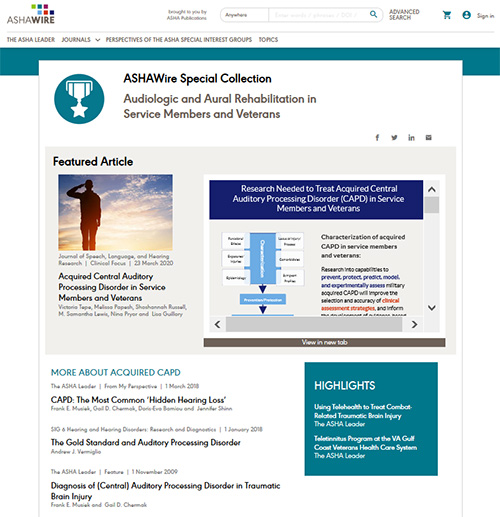It is well documented that people with a history of military service are at a significant risk for hearing loss and tinnitus due to noise exposure and ear damage. Further evidence now suggests that service members and veterans are also at risk for central auditory processing disorder (CAPD). An article by Tepe and colleagues in the Journal of Speech, Language, and Hearing Research focuses on the evidence and suggests the next steps that researchers should take.
CAPD may develop in adults with seemingly normal hearing thresholds, and testing for CAPD is not routine in most audiology clinics. Therefore, although audiologists may have been exposed to CAPD testing and treatment in the classroom, few have professional experience selecting, administering, and interpreting tests (Tepe et al., 2020, p. 846).
Although there has been little research focused on CAPD in service members and veterans, a combination of factors puts this population specifically at risk for CAPD. Research cited by Tepe et al. (2020) shows that blast exposure, neurotrauma, prolonged exposure to hazardous noise, and even exposure to chemicals found in jet fuel can put these individuals at risk. The authors break down each of these risk factors and discuss comorbid physical and mental diagnoses that can make identifying CAPD difficult.
Although most civilians who undergo CAPD testing are self-referred, military populations may be referred as part of a required health physical. The authors raise some important questions: “Are existing clinical practice guidelines suitable for use in the military population, and is there a test battery or intervention strategy that is optimal for use in this population?” (Tepe et al., 2020, p. 841).
Finally, Tepe and colleagues discuss current system-level challenges to getting assessment and treatment for service members. “Surveys of audiologists across the DoD and VA reveal staggering differences in how clinicians define, assess, and treat CAPD” (Tepe et al., 2020, p. 846). They provide a list of solutions—many of which can be implemented immediately—to address these problems.
ASHAWire Special Collections
This JSLHR clinical focus by Tepe et al. and its accompanying infographic serve as the featured article in a newly developed special collection, Audiologic/Aural Rehabilitation in Service Members and Veterans. ASHAWire Special Collections bring together—on a focused topic—an array of articles from all the publications on pubs.asha.org. We present these articles along with other relevant ASHA resources so you can further explore this or related topics.

We hope that this JSLHR article, its accompanying infographic, and the special collection are helpful resources when researching or treating military service members and veterans. As the JSLHR article by Tepe et al. (2020) shows, we’ve only scratched the surface of auditory risk factors unique to this population. You can view the special collection here or explore the individual articles below.
References
Tepe, V., Papesh, M., Russell, S., Lewis, M. S., Pryor, N., & Guillory, L. (2020). Acquired central auditory processing disorder in service members and veterans. Journal of Speech, Language, and Hearing Research, 63(3), 834–857. https://doi.org/10.1044/2019_JSLHR-19-00293
Explore the Special Collection
Beck, J. E., Zaugg, T. L., Egge, J. L., Lima, E. N., & Thielman., E. J. (2019). Progressive tinnitus management at two Veterans Affairs medical centers: Clinical implementation with modified protocols. American Journal of Audiology, 28(1S), 162–173. https://doi.org/10.1044/2018_AJA-TTR17-18-0040
Carlson, K. F., Gilbert, T. A., O’Neil, M. E., Zaugg, T. L., Manning, C. A., Kaelin, C., Thielman, E. J., Reavis, K. M., & Henry, J. A. (2019). Health care utilization and mental health diagnoses among veterans with tinnitus. American Journal of Audiology, 28(1S), 181–190. https://doi.org/10.1044/2018_AJA-TTR17-18-0042
Chandler, D. W. (2006). Blast-related ear injury in current U.S. military operations. The ASHA Leader, 11(9), 8–29. https://doi.org/10.1044/leader.FTR4.11092006.8
Cornis-Pop, M. (2006). A new kind of patient for speech-language pathologists. The ASHA Leader, 11(9), 6–28. https://doi.org/10.1044/leader.FTR3.11092006.6
Edmonds, C. M., Ribbe, C., Thielman, E. J., & Henry, J. A. (2017). Progressive tinnitus management Level 3 skills education: A 5-year clinical retrospective. American Journal of Audiology, 26(3), 242–250. https://doi.org/10.1044/2017_AJA-16-0085
Fagelson, M. (2015). Taming TBI-associated tinnitus. The ASHA Leader, 20(12), 52–54. https://doi.org/10.1044/leader.FTR3.20122015.52
Fagelson, M. A. (2007). The association between tinnitus and posttraumatic stress disorder. American Journal of Audiology, 16(2), 107–117. https://doi.org/10.1044/1059-0889(2007/015)
Helfer, T. (2008). Acoustic/blast injury surveillance in an army at war. The ASHA Leader, 13(7), 14–18. https://doi.org/10.1044/leader.FTR2.13072008.14
Henry, J. A., Griest, S., Austin, D., Helt, W., Gordon, J., Thielman, E., Theodoroff, S. M., Lewis, M. S., Blankenship, C., Zaugg, T. L., & Carlson, K. (2016). Tinnitus screener: Results from the first 100 participants in an epidemiology study. American Journal of Audiology, 25(2), 153–160. https://doi.org/10.1044/2016_AJA-15-0076
Henry, J. A., Thielman, E. J., Zaugg, T. L., Kaelin, C., Schmidt, C. J., Griest, S., McMillan, G. P., Myers, P., Rivera, I., Baldwin, R., & Carlson, K. (2017). Randomized controlled trial in clinical settings to evaluate effectiveness of coping skills education used with progressive tinnitus management. Journal of Speech, Language, and Hearing Research, 60(5), 1378–1397. https://doi.org/10.1044/2016_JSLHR-H-16-0126
Husain, F. T., Schmidt, S. A., Tai, Y., Granato, E. C., Ramos, P., Sherman, P., & Esquivel, C. (2019). Replicability of neural and behavioral measures of tinnitus handicap in civilian and military populations: Preliminary results. American Journal of Audiology, 28(1S), 191–208. https://doi.org/10.1044/2019_AJA-TTR17-18-0039
Moore, B. A., Moring, J. C., Hale, W. J., & Peterson, A. L. (2019). Incidence rates of tinnitus in active duty military service members between 2001 and 2015. American Journal of Audiology, 28(4), 866–876. https://doi.org/10.1044/2019_AJA-19-0029
Musiek, F. E., & Chermak, G. D. (2009). Diagnosis of (central) auditory processing disorder in traumatic brain injury. The ASHA Leader, 14(15), 16–19. https://doi.org/10.1044/leader.FTR3.14152009.16
Musiek, F. E., Chermak, G. D., Bamiou, D.-E., & Shinn, J. (2018). CAPD: The most common ‘hidden hearing loss’. The ASHA Leader, 23(3), 6–9. https://doi.org/10.1044/leader.FMP.23032018.6
Ortiz, C. (2016). The tinnitus-traumatic brain injury link. The ASHA Leader, 21(8), 16–17. https://doi.org/10.1044/leader.AEA.21082016.16
Schroy, C., Ortmann, A., & Mauzé, E. (2012). Sudden hearing loss following a traumatic head injury: A case study. Perspectives on Aural Rehabilitation and Its Instrumentation, 19(1), 15–24. https://doi.org/10.1044/arii19.1.15
Tepe, V., Papesh, M., Russell, S., Lewis, M. S., Pryor, N., & Guillory, L. (2020). Acquired central auditory processing disorder in service members and veterans. Journal of Speech, Language, and Hearing Research, 63(3), 834–857. https://doi.org/10.1044/2019_JSLHR-19-00293
Thompson, D. M. (2017). The sound—and the curing. The ASHA Leader, 22(9), 16–17. https://doi.org/10.1044/leader.AEA.22092017.16
Tomberlin, C. H. (2014). Teletinnitus program at the VA Gulf Coast Veterans Health Care System. Perspectives on Telepractice, 4(1), 23–29. https://doi.org/10.1044/teles4.1.23
Vermiglio, A. J. (2018). The gold standard and auditory processing disorder. Perspectives of the ASHA Special Interest Groups, 3(6), 6–17. https://doi.org/10.1044/persp3.SIG6.6
Wallace, G. L. (2006). Blast injury basics. The ASHA Leader, 11(9), 26–28. https://doi.org/10.1044/leader.FTR7.11092006.26
Wood, T. J., & Wolgemuth, K. (2019). Top-down vs. bottom-up: A case series in verbal working memory treatments for chronic traumatic brain injury deficits. Perspectives of the ASHA Special Interest Groups, 4(5), 1199–1213. https://doi.org/10.1044/2019_PERS-SIG19-2019-0014









